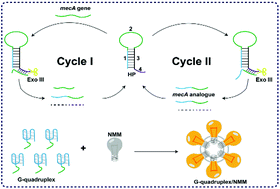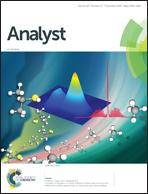Ultrasensitive and simple fluorescence biosensor for detection of the mecA gene of Staphylococcus aureus by using an exonuclease III-assisted cascade signal amplification strategy†
Abstract
In this work, a label-free fluorescence biosensor for ultrasensitive and simple detection of the mecA gene of Staphylococcus aureus was proposed by using an exonuclease III (Exo III)-assisted cascade signal amplification strategy. The 3′ end-extruding hairpin probe (HP) acted as the target recognition element and the caged G-quadruplex was used as the signal reporter. Without the mecA gene, the HP probe cannot be digested by Exo III, as the G-rich sequences are blocked in the stem of the HP probe. In the presence of the mecA gene, the hybridization of the mecA gene with the 3′ end-extruding HP probe triggers the digestion reaction of Exo III, liberating the mecA gene and the mecA gene analogue. Both the released mecA gene and the mecA gene analogue can hybridize with other HP probes and activate another round of the cleavage reaction. Consequently, the released free G-quadruplex is “lit up” by N-methylmesoporphyrin IX (NMM), displaying a dramatically enhanced fluorescence intensity. This sensing platform showed a high sensitivity towards the mecA gene with a detection limit as low as 2.4 fM without any labelling, immobilization, or washing steps. The designed sensing system also exhibits excellent selectivity for the mecA gene in the presence of other interfering DNA sequences. Furthermore, the presented biosensor is robust and has been successfully applied for the detection of the mecA gene in a real food sample with satisfactory results. Owing to its simplicity, cost-effectiveness and ultrasensitivity, our proposed sensing strategy provides a promising platform for the detection of other genes by substituting the target-recognition element.



 Please wait while we load your content...
Please wait while we load your content...